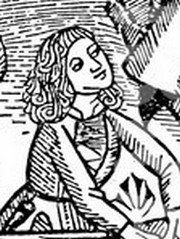This article is part of the series "A Moment in History" where we honor those who have contributed to the growth of medical knowledge in the areas of anatomy, medicine, surgery, and medical research.
Alessandra Giliani (1307 – 1326). Italian prosector and anatomist. Alessandra Giliani is the first woman to be on record as being an anatomist and prossector. She was born on 1307 in the town of Persiceto in northern Italy.
She was admitted to the University of Bologna circa 1323. Most probably she studied philosophy and the foundations of anatomy and medicine. She studied under Mondino de Luzzi (c.1270 – 1326), one of the most famous teachers at Bologna.
Giliani was the prosector for the dissections performed at the Bolognese “studium” in the Bologna School of Anatomy. She developed a technique (now lost to history) to highlight the vascular tree in a cadaver using fluid dyes which would harden without destroying them. Giliani would later paint these structures using a small brush. This technique allowed the students to see even small veins.
Giliani died at the age of 19 on March 26, 1326, the same year that her teacher Mondino de Luzzi died. It is said that she was buried in front of the Madonna delle Lettere in the church of San Pietro e Marcellino at the Hospital of Santa Maria del Mareto in Florence by Otto Agenius Lustrulanus, another assistant to Modino de Luzzi.
Some ascribe to Agenius a love interest in Giliani because of the wording of the plaque that is translated as follows:
"In this urn enclosed are the ashes of the body of
Alessandra Giliani, a maiden of Persiceto.
Skillful with her brush in anatomical demonstrations
And a disciple equaled by few,
Of the most noted physician, Mondino de Luzzi,
She awaits the resurrection.
She lived 19 years: She died consumed by her labors
March 26, in the year of grace 1326.
Otto Agenius Lustrulanus, by her taking away
Deprived of his better part, inconsolable for his companion,
Choice and deservinging of the best from himself,
Has erected this plaque"
Sir William Osler says of Alessandra Giliani “She died, consumed by her labors, at the early age of nineteen, and her monument is still to be seen”
The teaching of anatomy in the times of Mondino de Luzzi and Alessandra Giliani required the professor to be seated on a high chair or “cathedra” from whence he would read an anatomy book by Galen or another respected author while a prosector or “ostensor” would demonstrate the structures to the student. The professor would not consider coming down from the cathedra to discuss the anatomy shown. This was changed by Andreas Vesalius.
The image in this article is a close up of the title page of Mondino’s “Anothomia Corporis Humani” written in 1316, but published in 1478. Click on the image for a complete depiction of this title page. I would like to think that the individual doing the dissection looking up to the cathedra and Mondino de Luzzi is Alessandra Giliani… we will never know.
The life and death of Alessandra Giliani has been novelized in the fiction book “A Golden Web” by Barbara Quick.
Sources
1. “Books of the Body: Anatomical Ritual and Renaissance Learning” Carlino, A. U Chicago Press, 1999
2. “Encyclopedia of World Scientists” Oakes, EH. Infobase Publishing, 2002
3. “The Biographical Dictionary of Women in Science”Harvey, J; Ogilvie, M. Vol1. Routledge 2000
4. “The Evolution of Modern Medicine” Osler, W. Yale U Press 1921
5. “The Mondino Myth” Pilcher, LS. 1906
Original image courtesy of NLM




